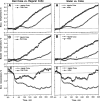Phasic and tonic fluctuations in brain, muscle, and skin temperatures during motivated drinking behavior in rats: physiological correlates of motivation and reward
- PMID: 19932691
- PMCID: PMC2812610
- DOI: 10.1016/j.brainres.2009.11.036
Phasic and tonic fluctuations in brain, muscle, and skin temperatures during motivated drinking behavior in rats: physiological correlates of motivation and reward
Abstract
Since brain metabolism is accompanied by heat production, measurement of brain temperature offers a method for assessing global alterations in metabolic neural activity. This approach, high-resolution (5-s bin) temperature recording from the nucleus accumbens (NAcc), temporal muscle, and facial skin, was used to study motivated drinking behavior in rats. Experienced animals were presented with a cup containing 5-ml of Coca-Cola(R) (Coke) beverage that resulted, within certain latencies, in initiation of a continuous chain of licking until all liquid was fully consumed. While cup presentation induced rapid, gradual NAcc temperature increase peaking at the start of drinking, temperatures slowly decreased during Coke consumption, but phasically increased again in the post-consumption period when rats were hyperactive, showing multiple interactions with an empty cup. Muscle temperatures followed a similar pattern, but the changes were weaker and delayed compared to those in the brain. Skin temperature rapidly dropped after cup presentation, steadily maintained at low levels during consumption, and slowly restored during the post-consumption period. Substitution of the expected Coke with either sugar-free Diet Coke(R) or water resulted in numerous drinking attempts but ultimately no consumption. During these tests, locomotor activation was much greater and more prolonged, brain and muscle temperatures increased monophasically, and their elevation was significantly greater than that with regular Coke tests. Food deprivation decreased drinking latencies, did not change the pattern of temperature fluctuations during Coke consumption, but temperature elevations were greater than in controls. Our data suggest sustained neural activation triggered by appetitive stimuli and associated with activational (seeking) aspects of appetitive motivated behavior. This seeking-related activation is rapidly ceased following consumption, suggesting this change as a neural correlate of reward. In contrast, inability to obtain an expected reward maintains neural activation and seeking behavior, resulting in larger deviations in physiological parameters.
Published by Elsevier B.V.
Figures









Similar articles
-
Fluctuations in nucleus accumbens extracellular glutamate and glucose during motivated glucose-drinking behavior: dissecting the neurochemistry of reward.J Neurochem. 2015 Feb;132(3):327-41. doi: 10.1111/jnc.12993. Epub 2015 Jan 8. J Neurochem. 2015. PMID: 25393775 Free PMC article.
-
Brain temperature and its role in physiology and pathophysiology: Lessons from 20 years of thermorecording.Temperature (Austin). 2019 Dec 3;6(4):271-333. doi: 10.1080/23328940.2019.1691896. eCollection 2019. Temperature (Austin). 2019. PMID: 31934603 Free PMC article. Review.
-
Differential effects of dopamine and opioid receptor blockade on motivated Coca-Cola drinking behavior and associated changes in brain, skin and muscle temperatures.Neuroscience. 2010 May 5;167(2):439-55. doi: 10.1016/j.neuroscience.2010.02.032. Epub 2010 Feb 16. Neuroscience. 2010. PMID: 20167257 Free PMC article.
-
Fluctuations in central and peripheral temperatures associated with feeding behavior in rats.Am J Physiol Regul Integr Comp Physiol. 2008 Nov;295(5):R1415-24. doi: 10.1152/ajpregu.90636.2008. Epub 2008 Sep 17. Am J Physiol Regul Integr Comp Physiol. 2008. PMID: 18799633 Free PMC article.
-
The role of nucleus accumbens dopamine in motivated behavior: a unifying interpretation with special reference to reward-seeking.Brain Res Brain Res Rev. 1999 Dec;31(1):6-41. doi: 10.1016/s0165-0173(99)00023-5. Brain Res Brain Res Rev. 1999. PMID: 10611493 Review.
Cited by
-
Fluctuations in brain temperature induced by lipopolysaccharides: central and peripheral contributions.Oxid Med Cell Longev. 2010 Sep-Oct;3(5):332-41. doi: 10.4161/oxim.3.5.13184. Epub 2010 Sep 1. Oxid Med Cell Longev. 2010. PMID: 21150339 Free PMC article.
-
Fluctuations in nucleus accumbens extracellular glutamate and glucose during motivated glucose-drinking behavior: dissecting the neurochemistry of reward.J Neurochem. 2015 Feb;132(3):327-41. doi: 10.1111/jnc.12993. Epub 2015 Jan 8. J Neurochem. 2015. PMID: 25393775 Free PMC article.
-
Brain temperature and its role in physiology and pathophysiology: Lessons from 20 years of thermorecording.Temperature (Austin). 2019 Dec 3;6(4):271-333. doi: 10.1080/23328940.2019.1691896. eCollection 2019. Temperature (Austin). 2019. PMID: 31934603 Free PMC article. Review.
References
-
- Abrams R, Hammel HT. Hypothalamic temperature in unanesthetized albino rats during feeding and sleeping. Am. J. Physiol. 1964;206:641–646. - PubMed
-
- Altschule MD. Emotion and circulation. Circulation. 1951;3:444–454. - PubMed
-
- Baker M, Cronin M, Mountjoy D. Variability of skin temperature in the waking monkey. Am. J. Physiol. 1976;230:449–455. - PubMed
-
- Barbano MF, Cador M. Various aspects of feeding behavior can be partially dissociated in the rat by the incentive properties of food and the physiological state. Behav. Neurosci. 2005;119:1244–1253. - PubMed
Publication types
MeSH terms
Substances
Grants and funding
LinkOut - more resources
Full Text Sources

